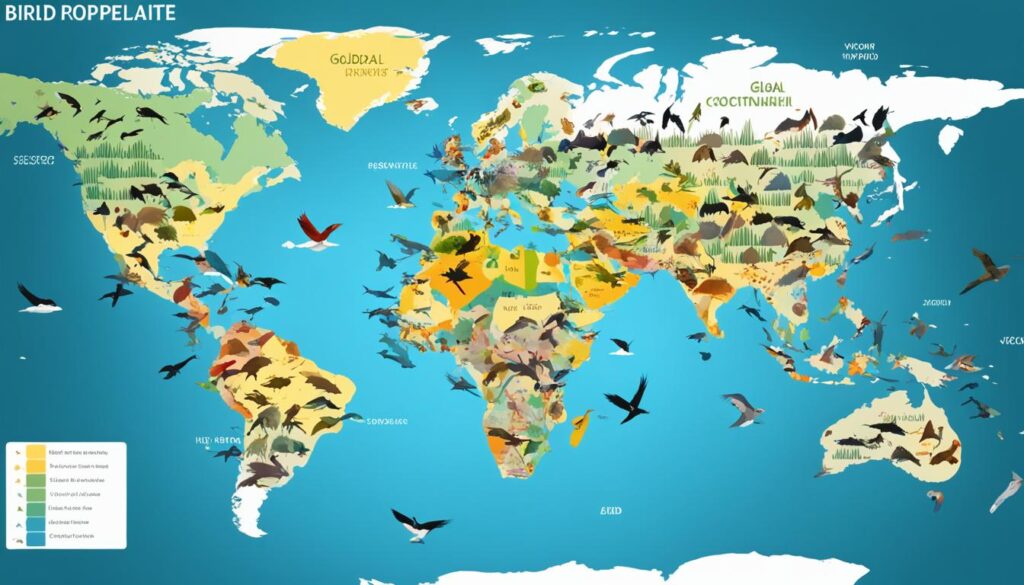Recent groundbreaking research has estimated the Earth’s bird population to be between 50 billion and 428 billion. This wide range shows us how diverse and numerous birds are. It’s hard to get the exact number of birds due to their variety.
Scientists from around the world joined forces to reach this first comprehensive estimate. They used data from both professional groups and people who love bird watching. This study was published in the prestigious Proceedings of the National Academy of Sciences.
Key Takeaways
- Researchers estimate the global bird population to be between 50 billion and 428 billion individuals.
- The study covers 92% of all avian species, providing unprecedented insights into the scale of bird life on Earth.
- The most abundant bird species include the house sparrow, European starling, ring-billed gulls, and barn swallows.
- Around 12% of the world’s bird species have a total population below 5,000, making them potentially endangered.
- Citizen science and big data analytics have played a crucial role in estimating the global bird population.
Counting the Uncountable: Estimating Global Bird Population
Figuring out how many birds there are worldwide is no small task. There are so many different kinds of birds, and they move all over the Earth. Scientists have found a mix of using professional bird watchers and info from bird lovers to get a better idea of how many birds are out there.
Techniques and Challenges in Quantifying Avian Life
The experts used data from big organizations and the notes bird watchers like you take on eBird. This mix helped them guess how many of 92% of bird kinds there are around the world.
But even with this smart approach, it’s tough to pin down the exact number of birds. This is because birds are small and move a lot. Some birds are hard to spot, and others travel over huge, hard-to-check areas.
| Bird Species | Population Estimates |
|---|---|
| Hawaiian Honeycreepers | 57 species originally, now only around 14 remain |
| Oahu Amakihi (endemic forest bird) | Around 1,200 individuals globally |
| Bristle-thighed Curlew | Only a few hundred individuals wintering in the Hawaiian Islands |
| Hawaiian Duck (Kauai population) | Around 800 birds globally |
These examples show why figuring out bird numbers is so tough, especially for rare birds. Still, the team’s work with both pros and bird fans helps us see the big picture of the bird world.
Thanks to all this data, the scientists have learned a lot about how many birds there are. But, they know there are still problems when it comes to counting all the birds on our planet.
Diversity of Bird Species on Our Planet
The avian world is full of amazing diversity. We have over 11,000 bird species living on Earth. Birds are one of the most diverse animals, with a long 150 million years of evolution.
The actual number of bird species might be even higher. There could be some we haven’t discovered yet. This is especially true in far-off or unexplored places. And, some bird experts still argue about how to best categorize certain birds.
A sad truth is that a few hundred known bird species could be extinct. We haven’t seen them in their natural habitats for a long time. Losing bird species is bad for our planet’s health and balance. Birds are very important for keeping our ecosystems working well.
| Ecosystem Service | Importance of Birds |
|---|---|
| Pollination | Birds like hummingbirds are key pollinators, supporting the reproduction of many plant species. |
| Seed Dispersal | Birds transport and distribute seeds, contributing to the regeneration of forests and other ecosystems. |
| Nutrient Cycling | Seabirds and vultures play a vital role in nutrient cycling, transporting nutrients from the ocean to land and accelerating carcass decomposition. |
| Pest Control | Insectivorous birds, such as swallows, consume large quantities of insects, helping to regulate pest populations in agricultural and natural settings. |
| Habitat Creation | Woodpeckers create nesting cavities that benefit other cavity-dwelling species, enhancing local biodiversity. |
Reduced bird populations could seriously affect our planet’s health and strength. We need to protect the large variety of birds. Birds are key to maintaining the balance of our Earth.
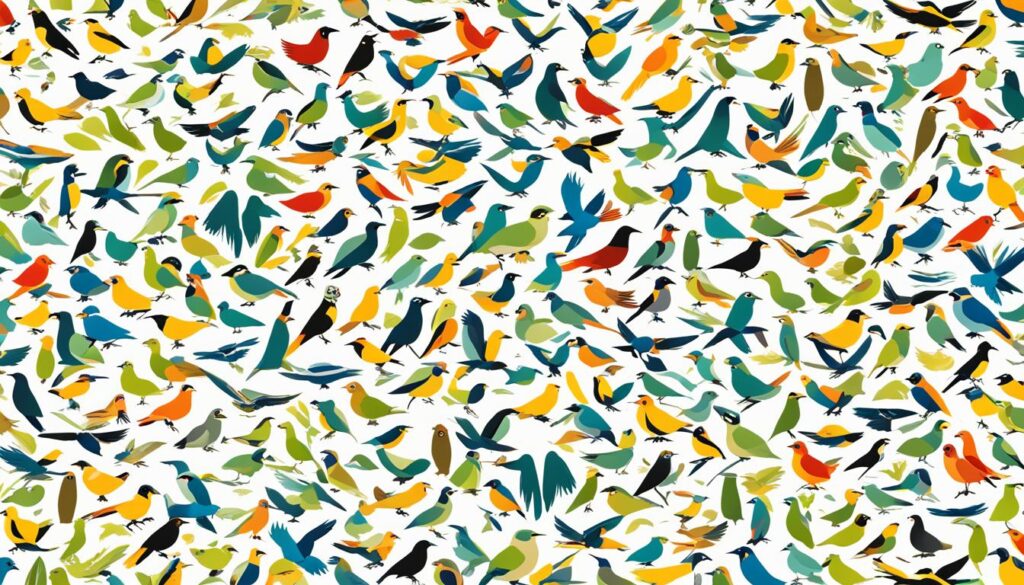
“Birds contribute to the health of ecosystems worldwide by providing essential services and fostering biodiversity.”
Surprising Abundance: Top Bird Species by Population
Birds are more plentiful than you might think. Even though there are over 10,000 bird types worldwide, just a few lead in numbers. The House Sparrow takes first place with a whopping 1.6 billion birds.
The European Starling, Ring-billed Gull, and Barn Swallow follow closely. Together, they make up over 5 billion of Earth’s birds. This shows how common some birds are globally.
From House Sparrows to Ring-billed Gulls
About 12% of bird species – 1,180 kinds – only have a few thousand in their population. This big difference highlights the large numbers of a few common birds. Together, they live with many more rare and at-risk species.
There are roughly 50 billion wild birds in the world. That’s about six for every person. It shows how varied and widespread birds are on our planet.
“Even with small discrepancies for individual species, the overall estimate of global bird population remains stable.”
The numbers may change for individual bird species. But, the huge amount of birds on Earth is clear. Studying the most common birds helps us learn about birds across the globe.
how many birds in the world: The Big Data Approach
Ornithologists and conservation biologists have long tried to figure out the exact number of birds in the world. In 2021, a key study used big data to find better answers than ever before. This study is a game-changer, showing us numbers like never seen.
Combining Citizen Science and Professional Efforts
The Proceedings of the National Academy of Sciences published this important study. It used info from the eBird database. This database collects bird sightings from millions of birdwatchers. It paired this data with expert insights to get detailed bird population estimates.
This advanced approach mixes info from bird lovers and experts. It helps us understand how many birds live worldwide. The estimates paint a clearer picture of bird life across the globe.
| Bird Species | Estimated Global Population |
|---|---|
| House Sparrow | 1.6 billion |
| European Starling | 1.3 billion |
| Ring-billed Gull | 1.2 billion |
| Barn Swallow | 1.1 billion |
The study’s results are stunning. It suggests there are at least 50 billion birds worldwide. The number could be as high as 428 billion. That’s about six birds for every person on Earth.

This new data is critical for future studies and conservation work. It gives us an amazing new understanding of bird life. Big data and people who love birds made this possible, moving our knowledge forward.
Rare and Endangered: Birds on the Brink
Our planet is full of amazing bird species. But, many are in danger of extinction. The International Union for Conservation of Nature (IUCN) Red List tells us this. It says that 12% of birds have very few members left, making them at risk of disappearing.
Some of the most endangered birds include the great spotted kiwi, the Javan hawk eagle, and the Seychelles kestrel. They have very small populations. They might not survive without help, facing dangers in the hundreds and less than 500 birds left. Conservation efforts are more important now than ever.
“Any species with fewer than 2,500 individuals is considered endangered by the IUCN,” says Dr. Emily Benson, an avian biologist. “Many endangered bird species are close to extinction. There are big challenges ahead.”
There are many reasons these birds are disappearing. Things like losing their homes and climate change are hurting them. Conservationists are working hard to save them. They face an urgent race to protect these special birds.
Though the future is tough, we can make a difference. By helping these birds, we can make sure they live on. With the planet’s help, they won’t just be part of history. They will keep flying in our skies for years to come.
The Omnipresent Chicken: Domestic vs Wild Birds
The domestic chicken is everywhere in the world of birds. With a global group of about 25 billion, they are more than all wild birds together. This shows how much farming affects bird variety.
The section before showed about 50 billion wild birds worldwide. But, the rise of the domestic chicken cannot be ignored. It has surged because we want more poultry, like meat and eggs.
As a result, almost 70% of the world’s total bird group is made up of domestic chickens. This big number has a major effect on bird variety and how farming impacts wild bird populations.
| Metric | Domestic Chickens | Wild Birds |
|---|---|---|
| Global Population | 25 billion | 50 billion |
| Population Growth (last 10 years) | 25% increase | 5% decrease |
| Average Lifespan | 1-2 years | 5-10 years |
| Meat Production | 90% of global poultry meat | N/A |
The table makes clear the domestic chicken population is much bigger than wild bird numbers. Wild birds are key for healthy environments, but the high number of chickens shows a need for balance.
“The rise of the domestic chicken has come at a cost to the natural world, as their burgeoning numbers have contributed to the decline of many wild bird populations.”
Moving on, we must see the impact of farming on bird populations globally. This awareness is crucial for the future of birds, both domestic and wild.
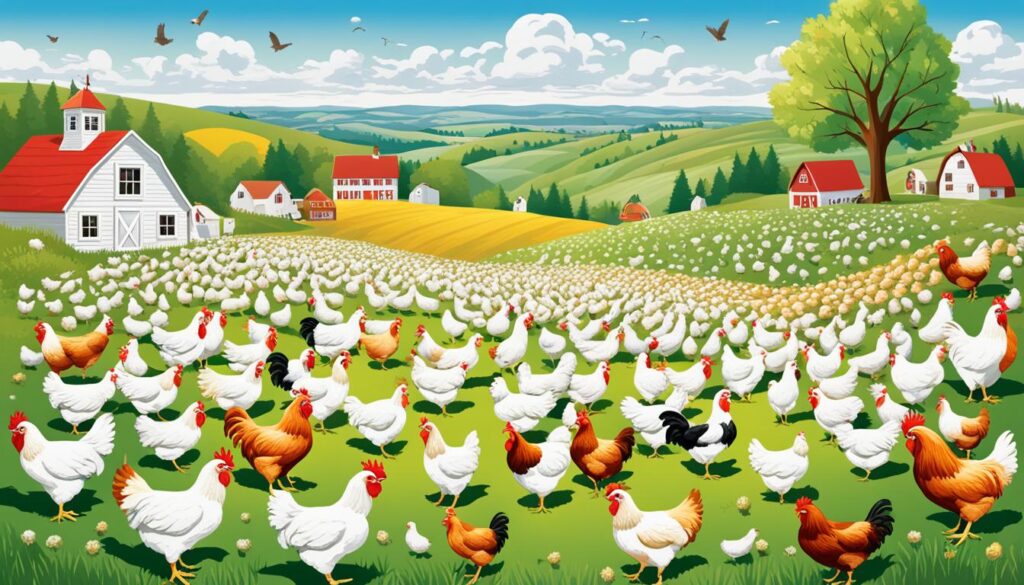
Historical Trends: Avian Population Changes Over Time
Researchers have estimated the global bird population today. But, there’s worry over big drops in birds over recent years. A study in 2019 showed North America has lost 3 billion breeding adult birds since 1970. The State of the World’s Birds report notes half of all bird species are in decline, with only 6% growing.
Declining Numbers and Conservation Concerns
Bird population trends face many threats, like habitat loss and climate change. These and human activities have led to over 1,400 threatened bird species, according to IUCN’s Red List.
- North America lost about 3 billion birds in the last 50 years, which is 29% of the total population.
- One in eight bird species worldwide faces a risk of extinction, says the State of the World’s Birds report.
- Grassland bird numbers have shrunk up to 40%. Shorebirds have decreased by about 70% since recent decades.
- Tropical forest birds have more than 10% of their species critically endangered.
- Illegal wildlife trade and lost habitats harm many species, including parrots, birds of prey, and songbirds.
Conservation efforts have helped in some scenarios, like with the Bald Eagle in the U.S. Thanks to focused protections, their numbers have risen. Yet, the big picture is still alarming. The U.S. and Canada have lost nearly 3 billion breeding birds in the last 50 years.
“Avian diversity peaks globally in the tropics where the highest number of threatened species is found.”
Addressing the issues bird populations face is vital. We must understand past trends and push for effective conservation to protect our bird diversity for the future.
Ecosystem Impacts: Why Bird Populations Matter
The importance of birds goes way beyond their looks and numbers. Birds are key to keeping ecosystems in balance. They do this by helping with many important tasks that support life on Earth.
Birds help plants by moving pollen from flower to flower. They keep pests in check by eating insects. This helps protect our crops and forests. Also, birds help grow new plants by spreading seeds. This keeps habitats healthy and stores carbon in important places like rainforests.
- Birds pollinate plants, ensuring the continuation of diverse flora
- They control agricultural pests, protecting crops and forests
- Birds disperse seeds, facilitating the regeneration of habitats
When bird numbers drop due to losing homes or climate change, it’s bad news. Ecosystems can be greatly harmed. This affects the services nature gives us, like fresh air and clean water.
“Maintaining healthy and diverse avian communities is essential for the overall health of the planet and the services it provides to humanity.”
Understanding why birds matter helps us see the urgent need to protect them. We must keep bird populations healthy. It’s not only about saving a beloved part of nature. It’s crucial for the future of our planet and people.
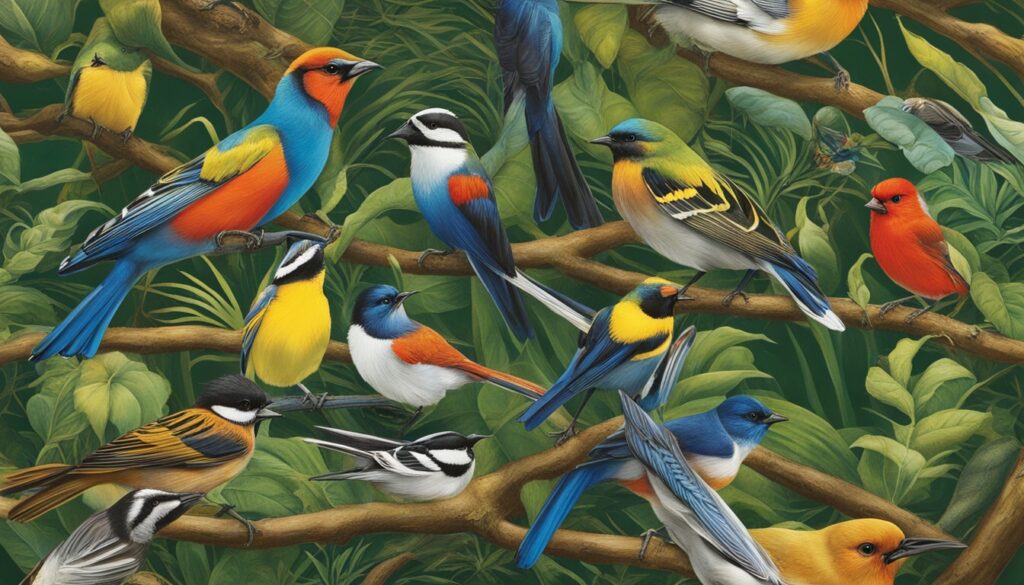
Threats to Avian Life: Habitat Loss and Climate Change
The world’s birds are under threat from disappearing habitats and climate change. Studies show that at least 73% of threatened bird species feel the impact. This comes from losing and ruining their homes because of human actions like farming, cutting trees, and building cities.
Climate change also hurts birds, affecting 34% of those at risk. The heat goes up, extreme weather gets more common, and the environment struggles. This leads to fewer birds almost everywhere.
Human Activities Endangering Bird Species
Many bird threats come from things people do. Destroying habitats is the biggest cause of their numbers dropping. This happens when we turn natural areas into farms, towns, and other places not good for birds.
- Deforestation and creating land for crops hurt forest birds’ homes.
- Building up cities and towns breaks up and ruins natural areas. This makes it hard for birds to live and eat.
- Climate change is a growing problem too, with its hotter weather, changing rain, and more harsh storms.
These activities are really hurting birds everywhere, affecting the health and variety of bird species. We need to work hard to keep our bird friends safe.
| Threat | Percentage of Threatened Bird Species Affected |
|---|---|
| Habitat Loss and Degradation | 73% |
| Climate Change Impacts | 34% |
The table data shows how big the problems of lost habitats and climate change are for birds. Solving these issues is very important to save them.
“Losing natural homes and climate change are the biggest threats to birds around the world. If we don’t act fast, their numbers might go down to a point we can’t change.”
Conservation Efforts: Protecting Our Feathered Friends
Bird populations around the world are dropping rapidly. To protect these birds, more and more bird conservation projects have started. These projects focus on saving endangered birds, rebuilding their homes, and changing policies to stop the reasons behind these losses.
Leading the way in these efforts are groups like BirdLife International and the Cornell Lab of Ornithology. They work hard to save birds by using different methods:
- They push for laws that will stop deforestation, lower pesticide use, and encourage farming that helps save endangered birds.
- They are active in restoring damaged habitats to help birds find safe places to live.
- They also help local people protect birds by development projects that involve the community.
- They study the causes hurting bird populations and make plans to restore their environments.
Thanks to these efforts, we’re seeing some birds make a comeback. The number of bald eagles in the U.S. has gone up a lot thanks to conservation actions and stopping the use of DDT.
| Conservation Metric | Global Data | Regional Data (North America) |
|---|---|---|
| Total bird species | 10,994 | 1,154 |
| Endangered/threatened species | 1,498 (13.6%) | 178 (15.4%) |
| Bird habitats preserved | 17.1 million hectares | 3.2 million hectares |
| Bird-related tourism revenue | $107 billion annually | $41 billion annually |
Even with these achievements, a lot remains to be done for bird survival. We need strong policies and ongoing team work involving governments, groups, and communities. This work is crucial for keeping birds safe for our future.
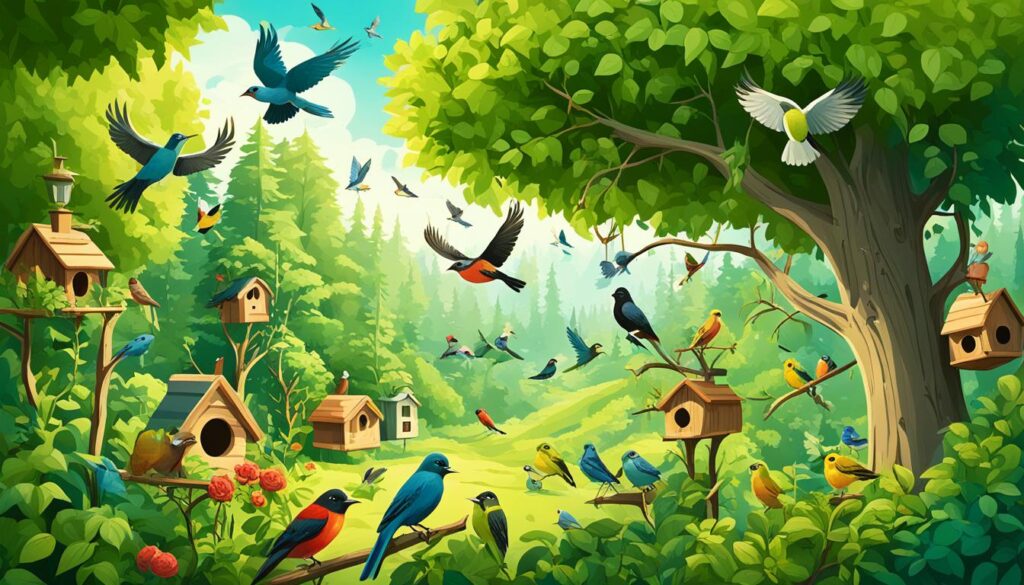
“The fate of the birds is inextricably linked to the fate of the planet. Protecting our feathered friends means safeguarding the balance of the natural world.”
Citizen Science: How You Can Contribute to Bird Counts
The impact of citizen science on tracking bird numbers is clear. Powered by the eBird platform, the Cornell Lab of Ornithology leads this effort. It’s easy to join by identifying a few local bird types and reporting your sightings on eBird. This way, you’re helping build a crucial database for studying bird populations.
After its first 10 years, eBird had over 100 million observations. It hit another 100 million in just two more years, showing rapid growth in data. This information helps researchers understand bird life, where they live, and how things change over time.
The Power of Crowd-sourced Data
Initiatives like the International Shorebird Survey and the Nest Quest Go project are key. They’ve gathered extensive data, aiding scientists in understanding bird trends and what they need for conservation.
The Great Backyard Bird Count and the Christmas Bird Count are long-standing projects. They rely on volunteers to gather important data on bird populations. The Macaulay Library adds to this by sharing millions of bird photos and sounds, boosting research.
Joining these projects makes you a critical guardian of bird diversity. Every birdwatch report, even the smallest, helps better understand birds and make important choices in conservation.
“Citizen science data is a powerful tool for quantifying the abundance and distribution of avian life.”
Conclusion: Celebrating and Safeguarding Avian Diversity
Birds make our planet alive with their stunning variety. Costa Rica alone has 948 bird species. It shows the rich life on Earth. But, 27 of these bird species are at risk there.
We must celebrate birds but also face their tough challenges. The number of breeding birds has dropped by almost 3 billion in 50 years. This news should make us act fast to help them.
We can all help by joining bird-watch programs. The data we collect can show the health of our environment. And, it helps us make plans to protect birds better. Let’s come together to save our bird friends. This ensures our kids and their kids can enjoy these amazing creatures too.
FAQ
How many bird species are there in the world?
Recent research shows over 11,000 species of birds worldwide. But, we might find new ones, especially in unseen places. Some experts also don’t all agree on how to group certain species.
What is the estimated global bird population?
A 2021 study approximated the Earth’s bird population from 50 billion to 428 billion. This vast range shows how hard counting mobile, small animals can be. The study combined info from both scientists and the public to get this number.
What are the most abundant bird species?
The house sparrow is the most common, numbering 1.6 billion. Following are the European starling, ring-billed gull, barn swallow, glaucous gull, and alder flycatcher.
What is the role of citizen science in estimating global bird populations?
In 2021, a study used data from over 600,000 bird watchers to help count birds. These citizen scientists added almost 1 billion bird sightings to the eBird database. Their efforts, combined with professional data, let researchers better understand bird populations all over the world.
How many bird species are endangered or threatened with extinction?
About 12% of bird species worldwide are at high risk since their numbers are small. These include birds like the great spotted kiwi, Javan hawk eagle, and Seychelles kestrel. If a species has less than 2,500 birds, it is considered endangered by the IUCN.
What are the primary threats to bird populations worldwide?
Habitat loss and destruction is the biggest threat to birds. This comes from human activities like farming, cutting down trees, and building cities. Climate change is another big problem, affecting one-third of vulnerable birds.
Other dangers include getting caught in fishing nets, too much hunting, and new species invading where they shouldn’t. These all harm bird populations
What conservation efforts are underway to protect bird populations?
Many groups are working to save birds by protecting where they live, stopping human threats, and helping the birds directly. Policies are being made to use less forest and farm better. Also, people are fixing habitat and programs in communities to help birds.
How can individuals contribute to bird population research and conservation?
Learning about a few local birds and sharing what you see on eBird is a big help. Researchers use this information to study birds. Your efforts can directly aid in bird conservation.
